Spatio-Temporal Variation in Soil Salinity and Its Influencing Factors in Desert Natural Protected Forest Areas
Abstract
:1. Introduction
2. Materials and Methods
2.1. Description of the Study Area
2.2. Data Collection and Processing
2.2.1. Measured SSC Data Processing
2.2.2. Remote Sensing Data Processing
2.2.3. Meteorological Data
2.3. Research Methods
2.3.1. Salinity Inversion Model Construction
- (1)
- Multiple Linear Regression (MLR)
- (2)
- Partial Least Squares Regression (PLSR)
- (3)
- Support Vector Machine (SVM)
- (4)
- Random Forest (RF)
- (5)
- Convolutional Neural Network (CNN)
2.3.2. Geodetector Model
- (1)
- Factor detector: it is used to detect the spatial variance of the dependent variable Y (SSC) and the magnitude of the spatial variance of the independent variable X (each influence factor) on Y, expressed as q:
- (2)
- Interaction detector: used to identify the interactions between different factors and assess whether two factors strengthen or weaken the explanatory power of the dependent variable.
3. Results
3.1. Spectral Index Preference
3.2. Model Selection
3.3. Spatial and Temporal Variations of SSC
3.4. Driving Factors of SSC
4. Discussion
4.1. Model Uncertainty Analysis
4.2. Mechanism of Salinity Change
4.3. Impacts of Soil Salinity Change on the ANPWF
5. Conclusions
Supplementary Materials
Author Contributions
Funding
Data Availability Statement
Conflicts of Interest
References
- Tian, F.; Hou, M.; Qiu, Y.; Zhang, T.; Yuan, Y. Salinity stress effects on transpiration and plant growth under different salinity soil levels based on thermal infrared remote (TIR) technique. Geoderma 2020, 357, 113961. [Google Scholar] [CrossRef]
- Hassani, A.; Azapagic, A.; Shokri, N. Global predictions of primary soil salinization under changing climate in the 21st century. Nat. Commun. 2021, 12, 6663. [Google Scholar] [CrossRef] [PubMed]
- Singh, A. Soil salinization management for sustainable development: A review. J. Environ. Manag. 2021, 277, 111383. [Google Scholar] [CrossRef] [PubMed]
- Yang, X.; Ali, A.; Xu, Y.; Jiang, L.; Lv, G. Soil moisture and salinity as main drivers of soil respiration across natural xeromorphic vegetation and agricultural lands in an arid desert region. Catena 2019, 177, 126–133. [Google Scholar] [CrossRef]
- Mougenot, B.; Pouget, M.; Epema, G. Remote sensing of salt affected soils. Remote Sens. Rev. 1993, 7, 241–259. [Google Scholar] [CrossRef]
- Allbed, A.; Kumar, L.; Aldakheel, Y. Assessing soil salinity using soil salinity and vegetation indices derived from IKONOS high-spatial resolution imageries: Applications in a date palm dominated region. Geoderma 2014, 230, 1–8. [Google Scholar] [CrossRef]
- Rao, B.; Sankar, T.; Dwivedi, R.; Thammappa, S.; Venkataratnam, L.; Sharma, R.; Das, S. Spectral Behavior of Salt-Affected Soils. Int. J. Remote Sens. 1995, 16, 2125–2136. [Google Scholar] [CrossRef]
- Hu, J.; Peng, J.; Zhou, Y.; Xu, D.; Zhao, R.; Jiang, Q.; Fu, T.; Wang, F.; Shi, Z. Quantitative Estimation of Soil Salinity Using UAV-Borne Hyperspectral and Satellite Multispectral Images. Remote Sens. 2019, 11, 736. [Google Scholar] [CrossRef]
- Xu, L.; Wang, Q. Retrieval of Soil Water Content in Saline Soils from Emitted Thermal Infrared Spectra Using Partial Linear Squares Regression. Remote Sens. 2015, 7, 14646–14662. [Google Scholar] [CrossRef]
- Zhang, S.; Zhao, G.; Wang, Z.; Xiao, Y.; Lang, K. Remote sensing inversion and dynamic monitoring of soil salt in coastal saline area. J. Agric. Resour. Environ. 2018, 35, 349–358. [Google Scholar] [CrossRef]
- Morgan, R.S.; Abd El-Hady, M.; Rahim, I.S. Soil salinity mapping utilizing sentinel-2 and neural networks. Indian J. Agric. Res. 2018, 52, 524–529. [Google Scholar] [CrossRef]
- Wang, N.; Xue, J.; Peng, J.; Biswas, A.; He, Y.; Shi, Z. Integrating Remote Sensing and Landscape Characteristics to Estimate Soil Salinity Using Machine Learning Methods: A Case Study from Southern Xinjiang, China. Remote Sens. 2020, 12, 4118. [Google Scholar] [CrossRef]
- Li, X.; Qiao, M.; Zhou, S. Causes and Spatial-temporal Changes of Soil Salinization in Manasi Irrigation Region of Xinjiang Region during 1985–2014. Bull. Soil Water Conserv. 2016, 36, 152–158. [Google Scholar]
- Connor, J.D.; Schwabe, K.; King, D.; Knapp, K. Irrigated agriculture and climate change: The influence of water supply variability and salinity on adaptation. Ecol. Econ. 2012, 77, 149–157. [Google Scholar] [CrossRef]
- Stavi, I.; Thevs, N.; Priori, S. Soil Salinity and Sodicity in Drylands: A Review of Causes, Effects, Monitoring, and Restoration Measures. Front. Environ. Sci. 2021, 9, 712831. [Google Scholar] [CrossRef]
- Meng, X.; Zhou, J.; Sui, N. Mechanisms of salt tolerance in halophytes: Current understanding and recent advances. Open Life Sci. 2018, 13, 149–154. [Google Scholar] [CrossRef] [PubMed]
- Chen, Y.; Yin, L.; Bai, X. The influences of surface water-overflowing disturbance on the fluctuations of Tamarix ramosissima community in Western China. Acta Ecol. Sin. 2010, 30, 245–250. [Google Scholar] [CrossRef]
- Zhang, W.; Xu, A.; Zhang, R.; Ji, H. Review of Soil Classification and Revision of China Soil Classification System. Sci. Agric. Sin. 2014, 47, 3214–3230. [Google Scholar]
- IUSS Working Group WRB. World Reference Base for Soil Resources. International Soil Classification System for Naming Soils and Creating Legends for Soil Maps; World Soil Resources Reports; Food and Agriculture Organization of the United Nations: Rome, Italy, 2015. [Google Scholar]
- Lu, Z.; Xu, D.; Zhang, X.; Zhao, Z.; Zhang, X. Impact of land use change on ecosystem services in arid desert region of Alxa. Res. Soil Water Conserv. 2019, 26, 296–302. [Google Scholar] [CrossRef]
- Xi, H.; Feng, Q.; Cheng, W.; Si, J.; Yu, T. Spatiotemporal variations of Alxa national public welfare forest net primary productivity in northwest China and the response to climate change. Ecohydrology 2022, 15, e2377. [Google Scholar] [CrossRef]
- Chen, X.; Duan, Z.; Luo, T. Changes in soil quality in the critical area of desertification surrounding the Ejina Oasis, Northern China. Environ. Earth Sci. 2014, 72, 2643–2654. [Google Scholar] [CrossRef]
- HJ 964-2018; Technical Guidelines for Environmental Impact Assessment—Soil Environment. Ministry of Ecology and Environment of the People’s Republic of China: Beijing, China, 2018.
- Sabri, E.M.; Boukdir, A.; Karaoui, I.; Arioua, A.; Messlouhi, R.; Idrissi, A.E.A. Modelling soil salinity in Oued EI Abid watershed, Morocco. E3S Web Conf. 2018, 37, 04002. [Google Scholar] [CrossRef]
- Allbed, A.; Kumar, L. Soil salinity mapping and monitoring in arid and semi-arid regions using remote sensing technology: A review. Adv. Remote Sens. 2013, 4, 373–385. [Google Scholar] [CrossRef]
- Chavez, P.; Berlin, G.; Sowers, L. Statistical-Method for Selecting Landsat MSS Ratios. J. Appl. Photogr. Eng. 1982, 8, 23–30. [Google Scholar]
- Yu, R.; Liu, T.; Xu, Y.; Zhu, C.; Zhang, Q.; Qu, Z.; Liu, X.; Li, C. Analysis of salinization dynamics by remote sensing in Hetao Irrigation District of North China. Agric. Water Manag. 2010, 97, 1952–1960. [Google Scholar] [CrossRef]
- Douaoui, A.; Nicolas, H.; Walter, C. Detecting salinity hazards within a semiarid context by means of combining soil and remote-sensing data. Geoderma 2006, 134, 217–230. [Google Scholar] [CrossRef]
- Zhang, Z.; Song, Y.; Zhang, H.; Li, X.; Niu, B. Spatiotemporal dynamics of soil salinity in the Yellow River Delta under the impacts of hydrology and climate. J. Appl. Ecol. 2021, 32, 1393–1405. [Google Scholar] [CrossRef]
- Bannari, A.; Guedon, A.; El-Harti, A.; Cherkaoui, F.; El-Ghmari, A. Characterization of Slightly and Moderately Saline and Sodic Soils in Irrigated Agricultural Land using Simulated Data of Advanced Land Imaging (EO-1) Sensor. Commun. Soil Sci. Plant Anal. 2008, 39, 2795–2811. [Google Scholar] [CrossRef]
- Abbas, A.; Khan, S.; Hussain, N.; Hanjra, M.; Akbar, S. Characterizing soil salinity in irrigated agriculture using a remote sensing approach. Phys. Chem. Earth 2013, 55–57, 43–52. [Google Scholar] [CrossRef]
- Khan, N.M.; Rastoskuev, V.V.; Sato, Y.; Shiozawa, S. Assessment of hydrosaline land degradation by using a simple approach of remote sensing indicators. Agric. Water Manag. 2005, 77, 96–109. [Google Scholar] [CrossRef]
- Huete, A. A Soil-Adjusted Vegetation Index (SAVI). Remote Sens. Environ. 1988, 25, 295–309. [Google Scholar] [CrossRef]
- Rouse, J. Monitoring the Vernal Advancement of Retrogradation (Green Wave Effect) of Natural Vegetation; NASA/GSFC Type III Final Report; NASA/GSFC: Greenbelt, MD, USA, 1974. [Google Scholar]
- Bannari, A.; Morin, D.; Bonn, F.; Huete, A. A review of vegetation indices. Remote Sens. Rev. 1995, 13, 95–120. [Google Scholar] [CrossRef]
- Alhammadi, M.; Glenn, E. Detecting date palm trees health and vegetation greenness change on the eastern coast of the United Arab Emirates using SAVI. Int. J. Remote Sens. 2008, 29, 1745–1765. [Google Scholar] [CrossRef]
- Marshall, F.; Smith, D.; Nickerson, D. Empirical tools for simulating salinity in the estuaries in Everglades National Park, Florida. Estuar. Coast. Shelf Sci. 2011, 95, 377–387. [Google Scholar] [CrossRef]
- Pahlavan-Rad, M.; Dahmardeh, K.; Hadizadeh, M.; Keykha, G.; Mohammadnia, N.; Gangali, M.; Keikha, M.; Davatgar, N.; Brungard, C. Prediction of soil water infiltration using multiple linear regression and random forest in a dry flood plain, eastern Iran. Catena 2020, 194, 104715. [Google Scholar] [CrossRef]
- Nawar, S.; Buddenbaum, H.; Hill, J.; Kozak, J. Modeling and Mapping of Soil Salinity with Reflectance Spectroscopy and Landsat Data Using Two Quantitative Methods (PLSR and MARS). Remote Sens. 2014, 6, 10813–10834. [Google Scholar] [CrossRef]
- Yu, H.; Liu, M.; Du, B.; Wang, Z.; Hu, L.; Zhang, B. Mapping Soil Salinity/Sodicity by using Landsat OLI Imagery and PLSR Algorithm over Semiarid West Jilin Province, China. Sensors 2018, 18, 1048. [Google Scholar] [CrossRef]
- Amari, S.; Wu, S. Improving support vector machine classifiers by modifying kernel functions. Neural Netw. 1999, 12, 783–789. [Google Scholar] [CrossRef] [PubMed]
- Diao, S.; Liu, C.; Zhang, T.; He, P.; Guo, Z.; Tu, J. Extraction of remote sensing information for lake salinity level based on SVM: A case from Badain Jaran desert in Inner Mongolia. Remote Sens. Nat. Resour. 2016, 28, 114–118. [Google Scholar]
- Mutanga, O.; Adam, E.; Cho, M. High density biomass estimation for wetland vegetation using WorldView-2 imagery and random forest regression algorithm. Int. J. Appl. Earth Obs. Geoinf. 2012, 18, 399–406. [Google Scholar] [CrossRef]
- Were, K.; Bui, D.; Dick, O.; Singh, B. A comparative assessment of support vector regression, artificial neural networks, and random forests for predicting and mapping soil organic carbon stocks across an Afromontane landscape. Ecol. Indic. 2015, 52, 394–403. [Google Scholar] [CrossRef]
- Wang, J.; Ding, J.; Abulimiti, A.; Cai, L. Quantitative estimation of soil salinity by means of different modeling methods and visible-near infrared (VIS-NIR) spectroscopy, Ebinur Lake Wetland, Northwest China. PeerJ 2018, 6, e4703. [Google Scholar] [CrossRef] [PubMed]
- Garajeh, M.; Blaschke, T.; Haghi, V.; Weng, Q.; Kamran, K.; Li, Z. A Comparison between Sentinel-2 and Landsat 8 OLI Satellite Images for Soil Salinity Distribution Mapping Using a Deep Learning Convolutional Neural Network. Can. J. Remote Sens. 2022, 48, 452–468. [Google Scholar] [CrossRef]
- Dai, X.; Peng, J.; Zhang, Y.; Luo, H.; Xiang, H. Prediction on Soil Salt Content Based on Spectral Classifi cation. Acta Pedol. Sin. 2016, 53, 909–918. [Google Scholar]
- Wang, J.; Xu, C. Geodetector: Principle and prospective. Acta Geogr. Sin. 2017, 72, 116–134. [Google Scholar]
- Wang, M.; Mo, H.; Chen, H. Study on Model Method of Inversion of Soil Salt Based on Multispectral Image. Chin. J. Soil Sci. 2016, 47, 1036–1041. [Google Scholar]
- Wang, X.; Zhang, F.; Ding, J.; Kung, H.; Latif, A.; Johnson, V.C. Estimation of soil salt content (SSC) in the Ebinur Lake Wetland National Nature Reserve (ELWNNR), Northwest China, based on a Bootstrap-BP neural network model and optimal spectral indices. Sci. Total Environ. 2018, 615, 918–930. [Google Scholar] [CrossRef]
- Jia, Y.; Zhao, C.; Nan, Z.; Wan, Y. Spatial heterogeneity of soil salinity in groundwater-fluctuating region of the lower reaches of the Heihe River. Acta Pedol. Sin. 2008, 45, 420–430. [Google Scholar]
- Zhang, X.; Zhou, J.; Lai, L.; Jiang, L.; Zheng, Y.; Shi, L. Spatial Characterization of Soil Water-salt and Nutrient in a Desert Riparian Area Along the Lower Reaches of Heihe River, China. Ecol. Environ. Sci. 2019, 28, 1739–1747. [Google Scholar]
- Bai, F.; Fang, G. Characteristics and causes of soil salinization in a typical interior arid basin in northwest China-the case of Heihe River Basin. Geotech. Investig. Surv. 2008, S1, 230–235. [Google Scholar]
- Fang, H.; Liu, G.; Kearney, M. Georelational analysis of soil type, soil salt content, landform, and land use in the Yellow River Delta, China. Environ. Manag. 2005, 35, 72–83. [Google Scholar] [CrossRef]
- Xiao, Y.; Zhao, G.; Li, T.; Zhou, X.; Li, J. Soil salinization of cultivated land in Shandong Province, China-Dynamics during the past 40 years. Land Degrad. Dev. 2019, 30, 426–436. [Google Scholar] [CrossRef]
- Zhao, C.; Li, S.; Feng, Z.; Shen, W. Dynamics of groundwater level in the water table fluctuant belt at the lower reaches of Heihe River. J. Desert Res. 2009, 29, 365–369. [Google Scholar]
- Xiao, S.; Xiao, H. Influencing Factors of Oasis Evolution in Heihe River Basin. J. Desert Res. 2003, 23, 385–390. [Google Scholar]
- Goto, K.; Goto, T.; Nmor, J.; Minematsu, K.; Gotoh, K. Evaluating salinity damage to crops through satellite data analysis: Application to typhoon affected areas of southern Japan. Nat. Hazards 2015, 75, 2815–2828. [Google Scholar] [CrossRef]
- Allbed, A.; Kumar, L.; Sinha, P. Soil salinity and vegetation cover change detection from multi-temporal remotely sensed imagery in Al Hassa Oasis in Saudi Arabia. Geocarto Int. 2018, 33, 830–846. [Google Scholar] [CrossRef]
- Chenchouni, H. Edaphic factors controlling the distribution of inland halophytes in an ephemeral salt lake “Sabkha ecosystem” at North African semi-arid lands. Sci. Total Environ. 2017, 575, 660–671. [Google Scholar] [CrossRef]
- Iqbal, T. Rice straw amendment ameliorates harmful effect of salinity and increases nitrogen availability in a saline paddy soil. J. Saudi Soc. Agric. Sci. 2018, 17, 445–453. [Google Scholar]
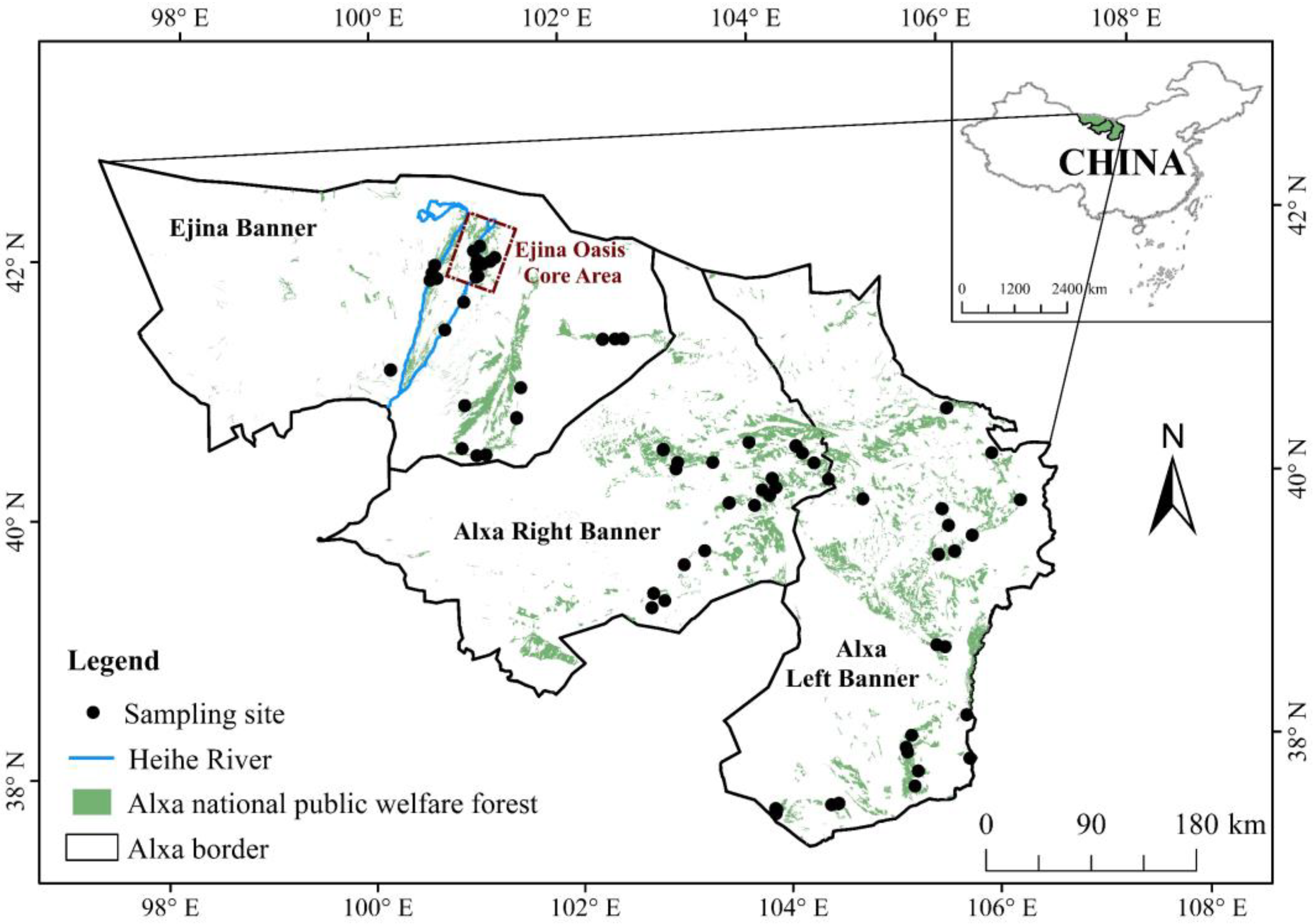
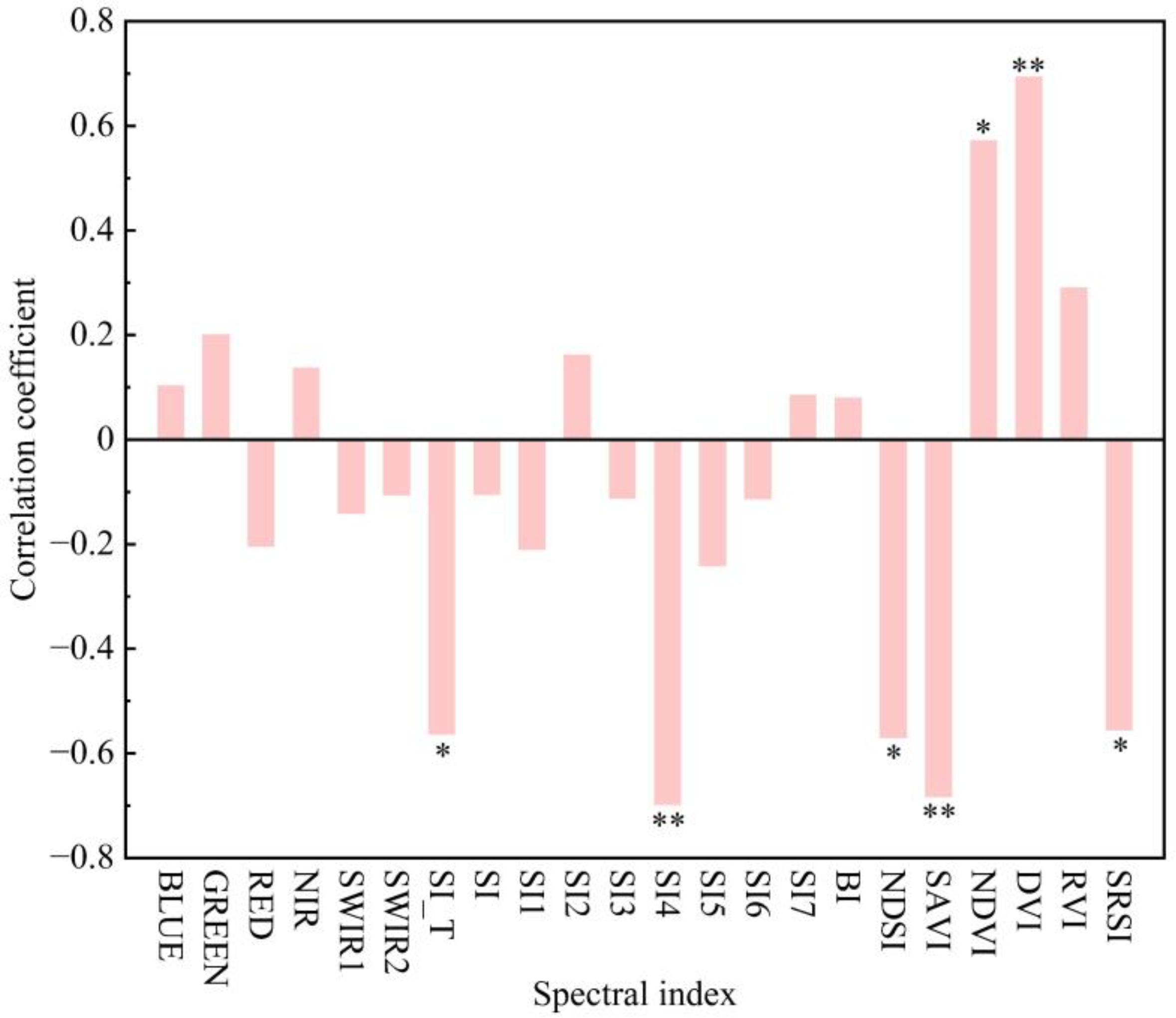

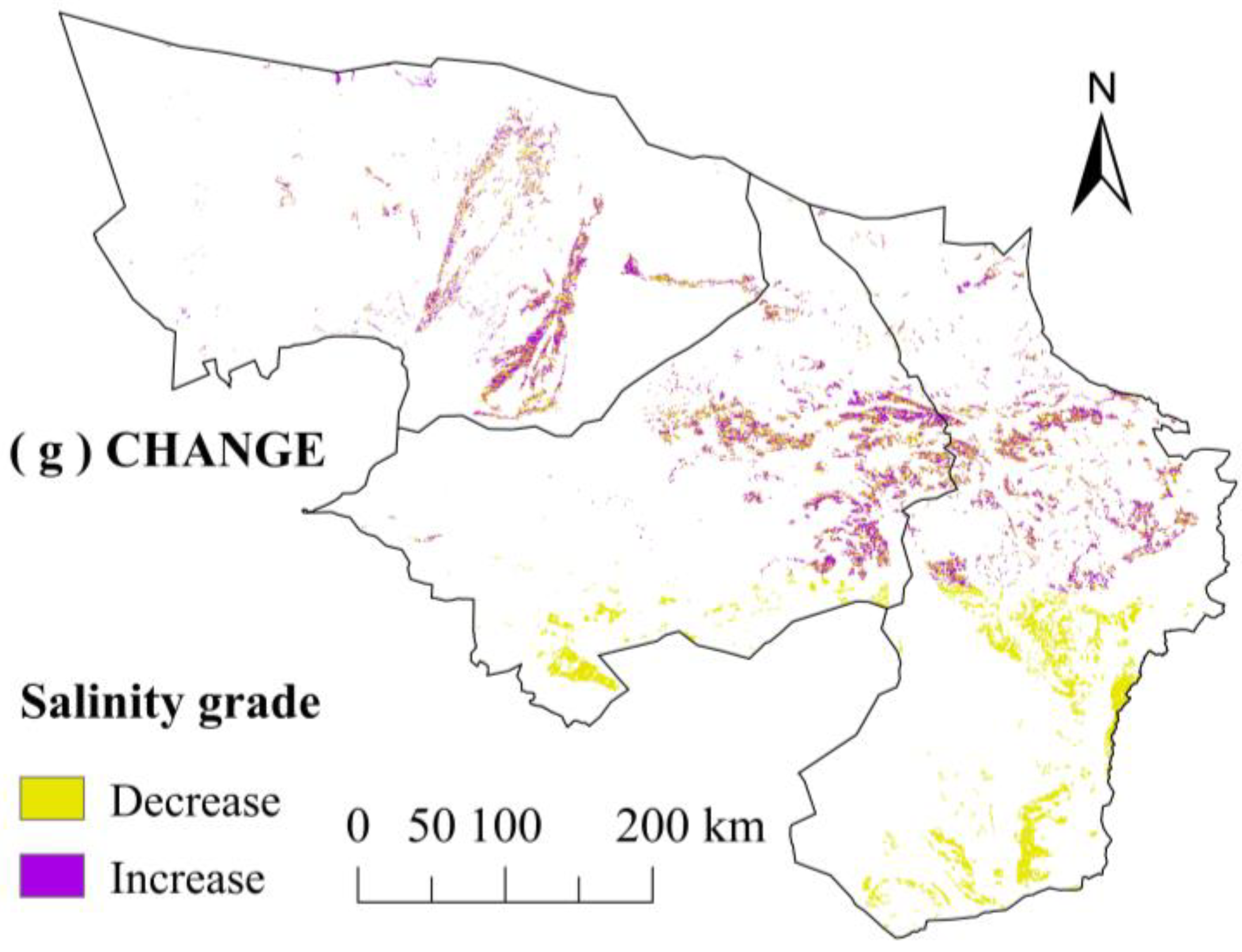
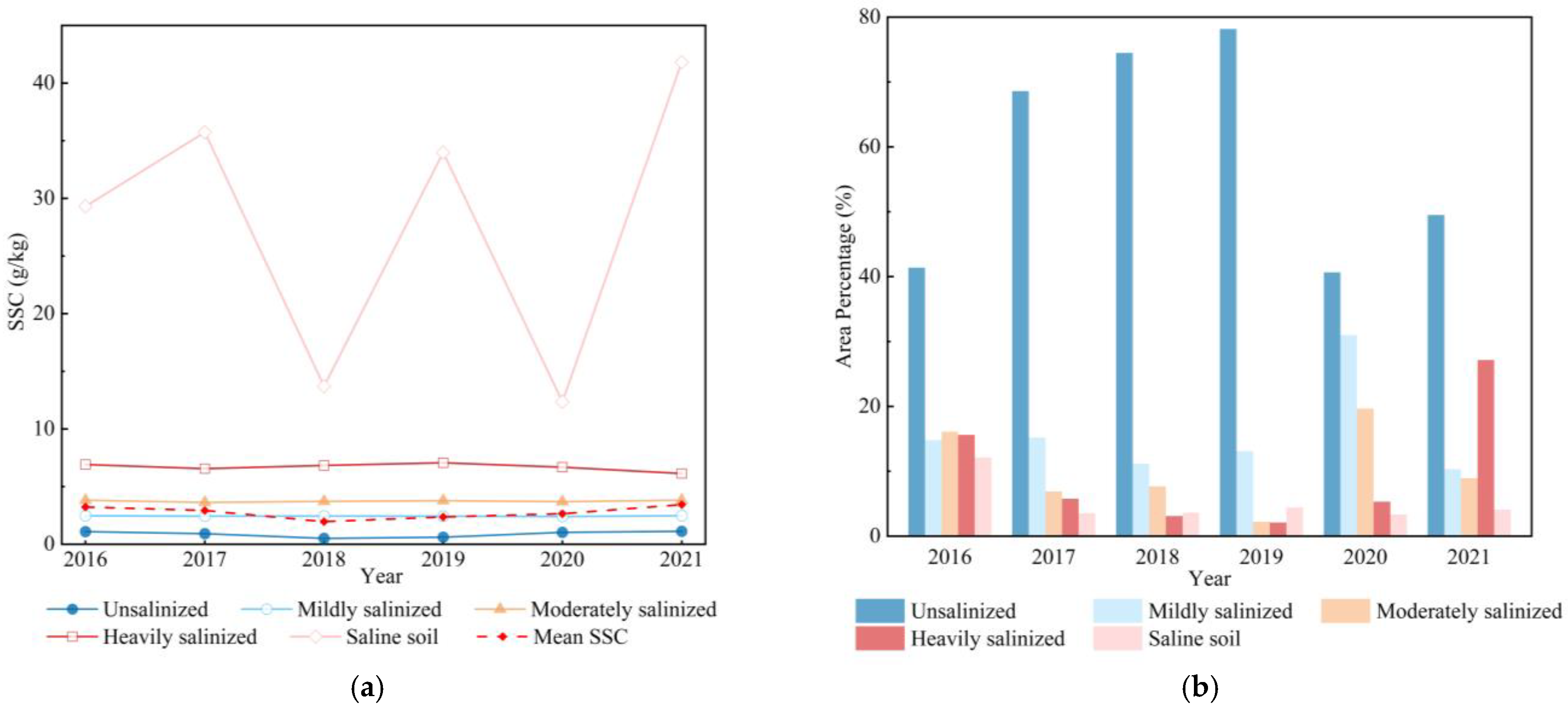

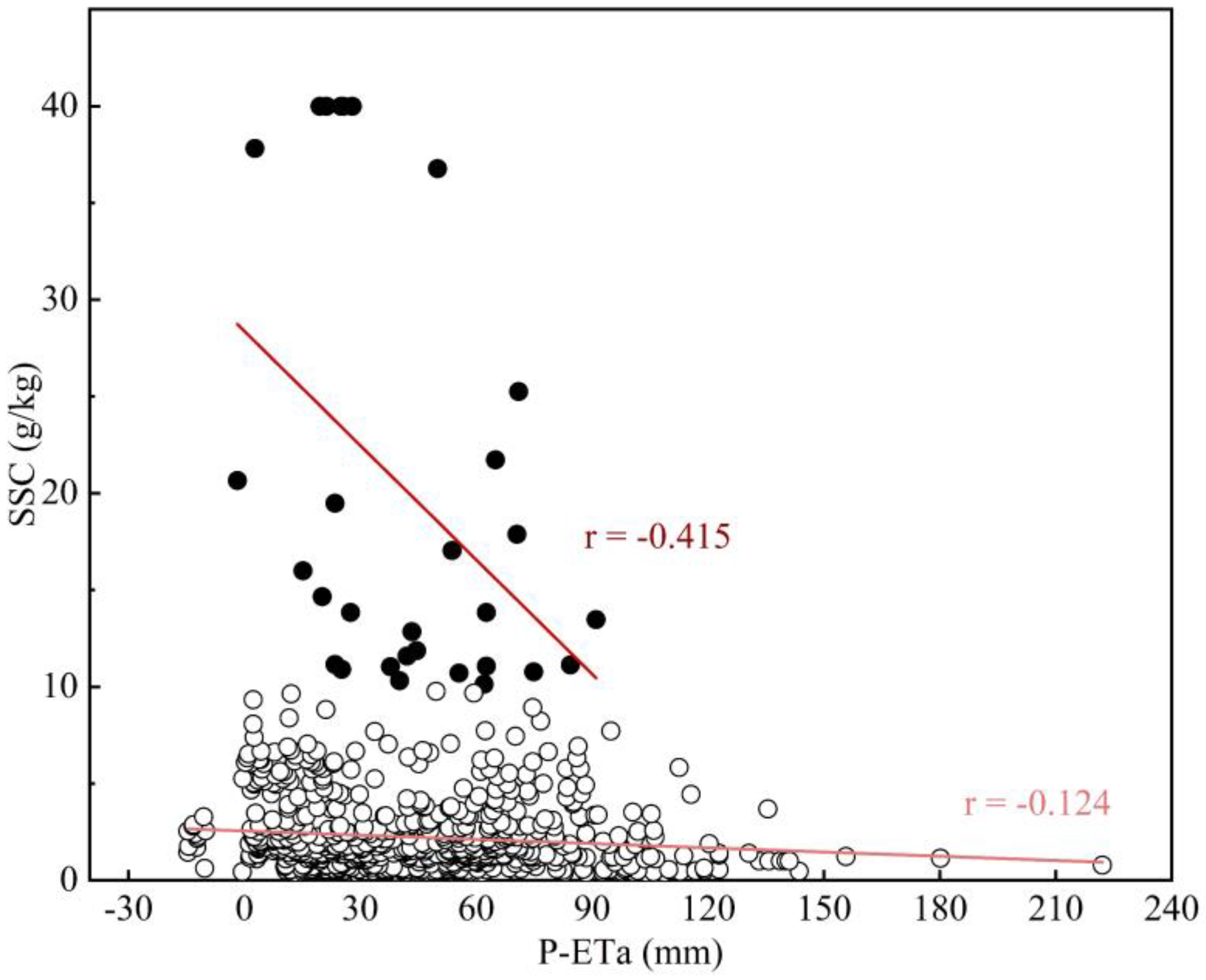

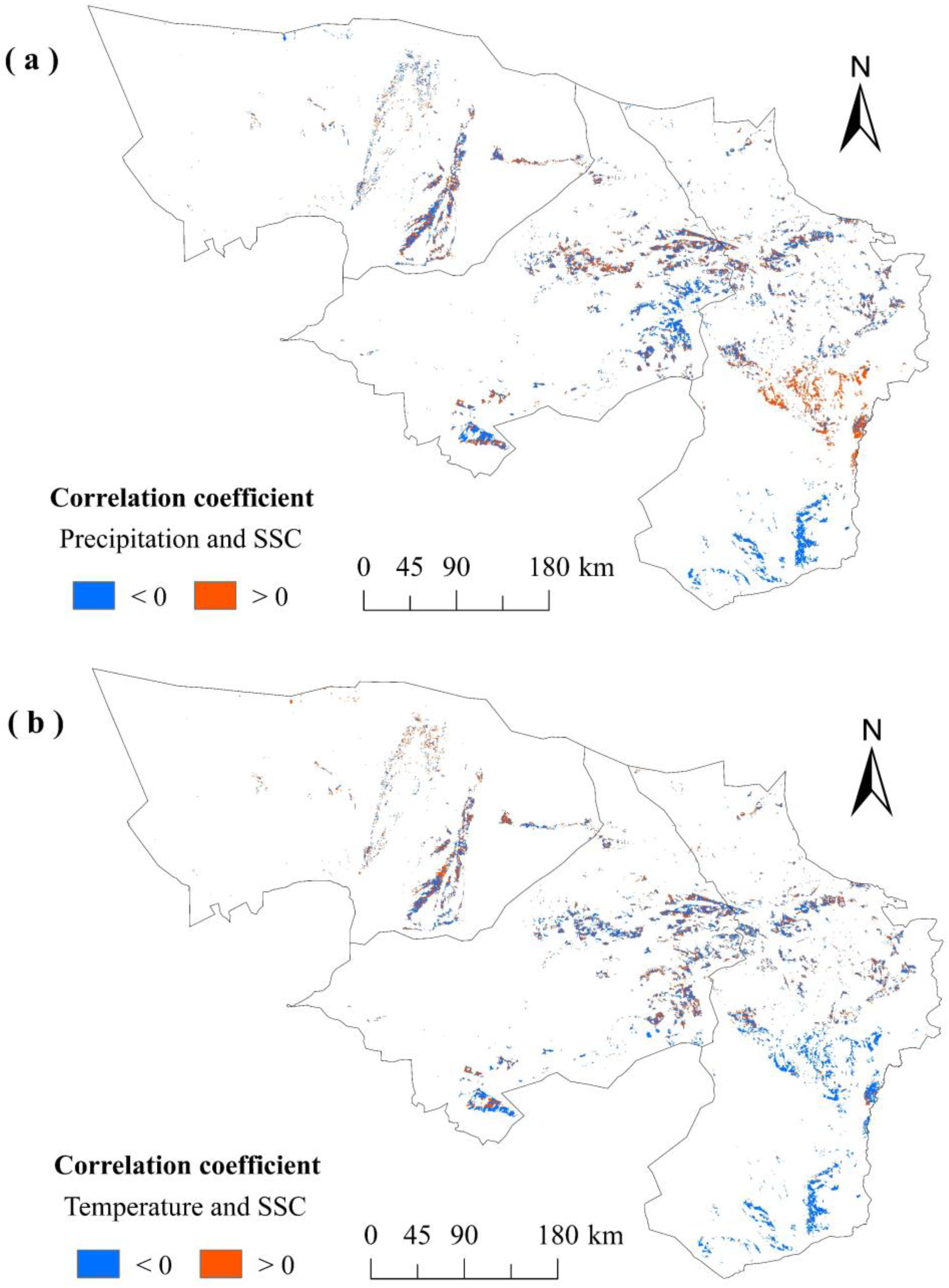
| Spectral Index | Formula | References |
|---|---|---|
| Salinity index (SI-T) | SI-T = Red/NIR × 100 | [6] |
| Salinity index (SI) | SI = | [6] |
| Salinity index (SI1) | SI1 = | [28] |
| Salinity index (SI2) | SI2 = | [28] |
| Salinity index (SI3) | SI3 = | [28] |
| Salinity index (SI4) | SI4 = SWIR1/NIR | [29] |
| Salinity index (SI5) | SI5 = (Red − SWIR1)/(Red + SWIR1) | [30] |
| Salinity index (SI6) | SI6 = Blue × Red/Green | [31] |
| Salinity index (SI7) | SI7 = Red × NIR/Green | [31] |
| Brightness Index (BI) | BI = | [32] |
| Normalized difference salinity index (NDSI) | NDSI = (Red − NIR)/(Red + NIR) | [32] |
| Soil condition vegetation index (SAVI) | SAVI = (NIR − Red) × 1.5/(NIR + Red + 0.5) | [33] |
| Normalized difference vegetation index (NDVI) | NDVI = (NIR − Red)/(NIR + Red) | [34] |
| Difference vegetation index (DVI) | DVI = NIR − Red | [35] |
| Ratio vegetation index (RVI) | RVI = NIR/Red | [35] |
| Salinity Remote Sensing Index (SRSI) | SRSI = | [36] |
| Layer | Parameters |
|---|---|
| Conv1D | filters = 14, kernel_size = 2 |
| AveragePool | pool_size = 2 |
| Dense_1 | units = 48 |
| Dense_2 | units = 24 |
| Dense_3 | units = 1 |
| Total parameters = 2131 | |
| Modeling Method | R2 | NRMSE | RPD |
|---|---|---|---|
| CNN | 0.745 | 0.090 | 1.979 |
| RF | 0.650 | 0.105 | 1.690 |
| SVM | 0.412 | 0.136 | 1.304 |
| PLSR | 0.622 | 0.109 | 1.627 |
| MLR | 0.597 | 0.113 | 1.575 |
| Year | Number of Samples | Maximum (g/kg) | Minimum (g/kg) | Mean (g/kg) | Standard Deviation (g/kg) | Cv |
|---|---|---|---|---|---|---|
| 2016 | 40 | 25.35 | 0.33 | 2.54 | 5.43 | 2.14 |
| 2017 | 42 | 32.53 | 0.19 | 2.55 | 6.10 | 2.39 |
| 2018 | 42 | 42.47 | 0.28 | 2.25 | 6.59 | 2.93 |
| 2019 | 34 | 41.75 | 0.24 | 2.92 | 8.30 | 2.84 |
| 2021 | 38 | 37.72 | 0.18 | 3.06 | 7.65 | 2.50 |
Disclaimer/Publisher’s Note: The statements, opinions and data contained in all publications are solely those of the individual author(s) and contributor(s) and not of MDPI and/or the editor(s). MDPI and/or the editor(s) disclaim responsibility for any injury to people or property resulting from any ideas, methods, instructions or products referred to in the content. |
© 2023 by the authors. Licensee MDPI, Basel, Switzerland. This article is an open access article distributed under the terms and conditions of the Creative Commons Attribution (CC BY) license (https://creativecommons.org/licenses/by/4.0/).
Share and Cite
Zhao, X.; Xi, H.; Yu, T.; Cheng, W.; Chen, Y. Spatio-Temporal Variation in Soil Salinity and Its Influencing Factors in Desert Natural Protected Forest Areas. Remote Sens. 2023, 15, 5054. https://doi.org/10.3390/rs15205054
Zhao X, Xi H, Yu T, Cheng W, Chen Y. Spatio-Temporal Variation in Soil Salinity and Its Influencing Factors in Desert Natural Protected Forest Areas. Remote Sensing. 2023; 15(20):5054. https://doi.org/10.3390/rs15205054
Chicago/Turabian StyleZhao, Xinyue, Haiyang Xi, Tengfei Yu, Wenju Cheng, and Yuqing Chen. 2023. "Spatio-Temporal Variation in Soil Salinity and Its Influencing Factors in Desert Natural Protected Forest Areas" Remote Sensing 15, no. 20: 5054. https://doi.org/10.3390/rs15205054





